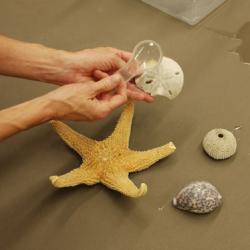Source Institutions
Source Institutions
Add to list Go to activity
Activity link broken? See if it's at the internet archive

In this activity, learners observe hard parts of sea creatures (shells, molts, etc.) to better understand marine environments. A series of questions is provided to help guide learners through observations, and there are suggestions for adapting the questions to fit older and younger audiences. Background information is provided about gastropods (e.g. whelks), mollusks (e.g. clams, mussels, oysters), echinoderms (e.g. sea stars, sand dollars), and crustaceans (e.g. crabs). The activity is written for use in a science museum or aquarium, but could also be used anywhere you can set out the examples and have learners interact with them. You could even adapt the activity for exploring outdoors at a tide pool or similar place.
- Under 5 minutes
- 10 to 30 minutes
- $10 - $20 per group of students
- Ages 4 - adult
- Activity
- English
Quick Guide
Materials List (per group of students)
- Shells, Molts, Tests, skeletons (choose mostly sturdy specimens so they can be handled by visitors)
- Pictures of the organisms shown in their habitat
- Books about shells (e.g. Eyewitness book by Alex Arthur)
- Large habitat picture to place behind you-space permitting (if there is no related display close-by)
- Paper and pencils for visitors to make a written or drawn record of questions/ideas that they have
- Hand lenses for investigating objects
Subjects
-
Life Sciences
-
Diversity of Life
- Animals
-
Ecology
- Ecosystems
- Biodiversity
-
Diversity of Life
-
The Nature of Science
-
The Scientific Process
- Asking Questions
- Formulating Explanations
-
The Scientific Process
Informal Categories
- Animals
Audience
To use this activity, learners need to:
- see
- hear
- touch
Learning styles supported:
- Involves hands-on or lab activities
Other
Includes alignment to state and/or national standards:
This resource is part of:
Access Rights:
- Free access
By:
Rights:
- All rights reserved, Virginia Aquarium and Marine Science Center, 2009
Funding Source:
- National Science Foundation, NSF OCE-0731338
